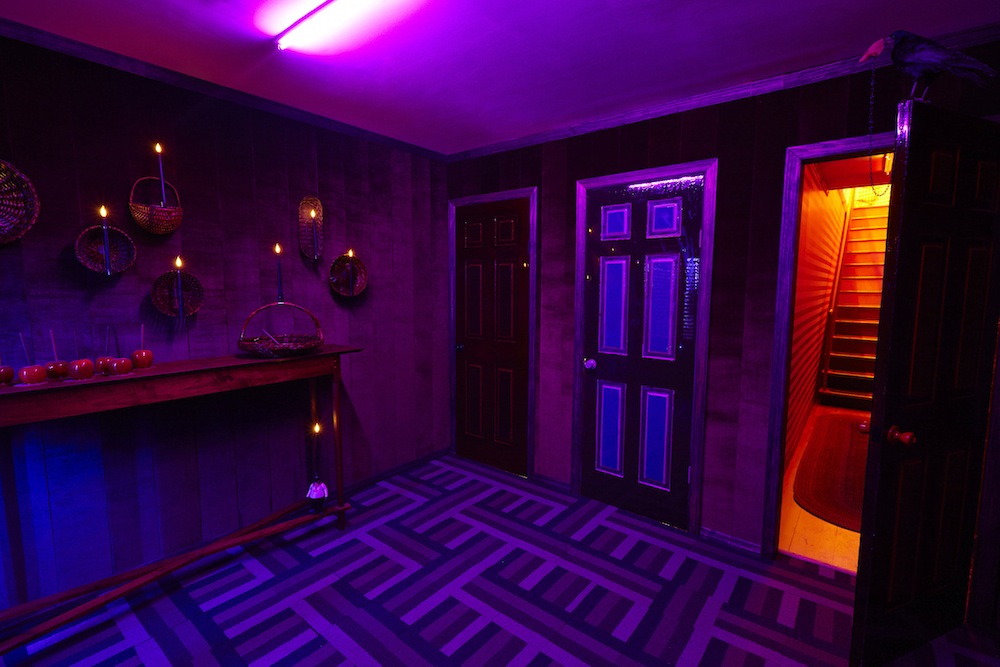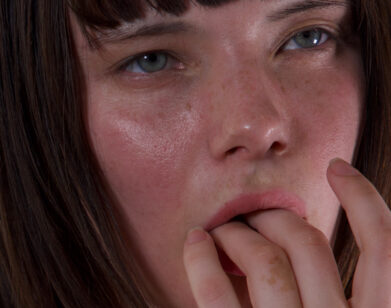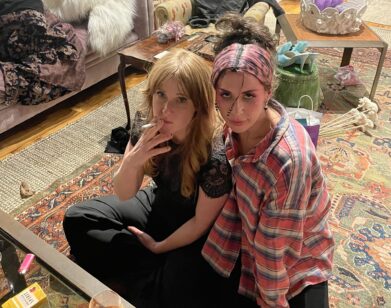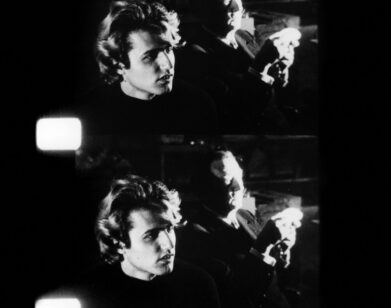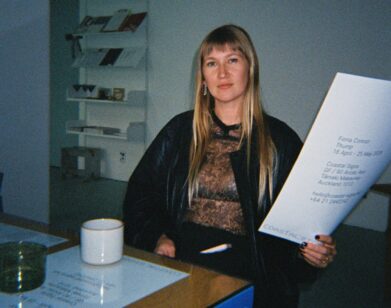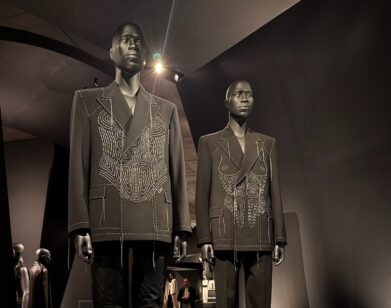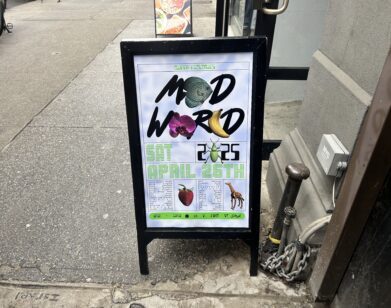Alex Da Corte’s Haunt
Not many would choose to spend time building an elaborate and psychologically disturbing haunted house in the dead of a Northeast winter and debut it to the public on the brink of spring. But not many people are like Alex Da Corte, who is known for his ambitious, expansive installations of found and modified objects. The final product blends personal and external elements to make a multifaceted, enduring whole and a lasting impression.
For his first solo show at Luxembourg & Dayan, the Philadelphia-based artist relocated to New York for five weeks to transform the gallery’s Upper East Side townhouse into an supernatural five-story exhibit titled “Die Hexe,” which means “The Witch” in German. It channels, among other things, his grandmother, Kurt Cobain, and The Mamas & the Papas, who formerly inhabited the building. Da Corte also incorporated works by a few of his own artistic influences: Robert Gober, Mike Kelley, Bjarne Melgaard, and Haim Steinbach each have pieces interwoven in the house’s sprawling collection of objects; there’s also a Listerine-scented morgue, a stripper pole, a pumpkin, a possessed rocking chair and dozens more strange, symbolic knick-knacks and items of furniture. Combined to make unnerving tableaus, everything is strategically placed in bizarre and vivid interiors, custom-designed by Da Corte. Moods shift dramatically from level to level, an effect driven by eerie lighting which ranges from dark purple to orange to burlesque pink to natural to acid green. It’s all condensed to fit the house’s 12-and-a-half foot wide dimensions.
Da Corte was born in New Jersey, and received an MFA in sculpture from Yale in 2010. He’s had solo shows and been included in group shows worldwide, and will have his first museum solo exhibition at MASS MoCA next year. Shortly before the opening, Da Corte connected with his good friend, the artist Sam McKinniss, to talk about “Die Hexe.”—Rachel Small
ALEX DA CORTE: Hi, Sam!
SAM McKINNISS: How are you today?
DA CORTE: I’m great. What’s going on?
McKINNISS: Oh, nothing. I’m just at home. I’ve been thinking about you all day. [both laugh] No, I have. Are you at Luxembourg & Dayan right now?
DA CORTE: I am, in this house.
McKINNISS: It’s so exciting to see you make art for the context of the house on East 77th Street, and it seems weirdly appropriate to you. I’ve been wondering, with you having been there for weeks, what it’s been like to live through the coldest, worst winter of all time, and be in this really creepy house.
DA CORTE: Yeah, well, it’s been really psychotic. It’s definitely been really intense on the brain because, when I started installing, the very first thing I did was block out all the light in the entire house. It’s a really narrow house, the second narrowest house in Manhattan. It does have really beautiful light and windows on every floor, and I walled off all of those windows immediately.
McKINNISS: It’s like an insane asylum in there right now.
DA CORTE: It is, a bit. I think that because you can hear everything on every floor all the time. The install has been kind of wild. The moments we would leave, which would be very late at night, were kind of shocking. It was like being dumped into a bucket of cold water after being in a hot space all day—hot because of the colors, hot because of the light, hot because of the intensity of it.
McKINNISS: The way that it looks and the way that you’ve made it is totally a world of your own devising, and that world is so mentally unfit for living.
DA CORTE: That’s the funny thing: In order to figure out how the colors and lights are working in the space, it takes so much looking and experimenting. As we were building the environment for the work, you have all of these trials when you’re setting up a whole roll of peach-colored light or red light…After working in there all day doing construction, you start to be affected by those lights. If the work’s purpose is to induce fear or anxiety or anger or hunger, it’s doing those things—but at the same time, you’re just trying to work.
McKINNISS: I was there last week, and it’s totally demonic in there. One thing that I did to myself for the past few days in a row, including today, was listen on repeat to this song by Mama Cass Elliot called The Room Nobody Lives In. I got into it because I was thinking about your show. She sings about an empty house or an abandoned house that is now haunted, and it’s dying for some human kindness or human interaction. When you told me what you were doing for this show—and that there was a direct line of inspiration coming from The Mamas & the Papas being former residents of this house—I was thrilled. Thrilled! Their music is so fun and cheerful and popular, but there are so many demonic forces at play behind that whole group dynamic.
DA CORTE: Well, yeah! Their relationship is so fraught. It’s like Fleetwood Mac, too. We know that their songs are what they are, but then we also know the interworkings of the people in the band and their relations and love and unrequited love…That definitely haunts the space, too, given that they were residents here towards the end of their lives.
McKINNISS: That completely fucked me up in the head for a few days thinking about that. But because I know your work so well, I was thrilled that you were willing to take that on because it’s such unexpected news for artists our age.
DA CORTE: It’s hard to also think about because they’re talking about ghosts or loss, but not in a goth way. It’s a different kind of poetry. There’s a challenge to talk about those things, which are actually impossible to catch because they’re not physical. You can’t portray absence. Or how do you portray absence? All the work is about the special effects of architecture or lighting that are actually not spooky candles and black cats. It’s something else that’s about making a space vibrate in terms of strange energies or something in the room. You have to physically build that into a space, but then it has to recede.
McKINNISS: It comes in and out, right? It’s like inhaling a cigarette and then exhaling the smoke. It’s filled with noir, romance, and terror, and it’s so sexy.
DA CORTE: It is sexy. Those things aren’t identifiable. We feel those things, but we don’t see those things. The manifestation of these things we’re talking about—romance, noir—they’re sort of unidentifiable, but there’s a mood. But how do you share a mood without it being melodramatic or overly theatrical or explicit? How do you talk about sex without showing sex? Like the cigarette smoke, the smoke isn’t there and then it’s there.
McKINNISS: How do you become ineffable? That’s what so challenging about your work.
DA CORTE: Well that, but the funny thing is that you paint ghosts. You paint cartoon ghosts. So in painting ghosts, you can’t be talking about ghosts because the ghosts are already there, so they’re already doing your job.
McKINNISS: I know because you and I—we would probably like to do this, but we don’t, we can’t—we would really love to sit around and ruminate on past recollections of either different times we’ve been slighted or different times we’ve been wooed or different times we’ve been betrayed or satisfied. I think both you and I would prefer to sit around and ruminate and try and feel those things over and over again. But we have to make art. We have to make things that are about color and material.
DA CORTE: Welp… [both laugh] I just built a house.
McKINNISS: Yeah, you basically did.
DA CORTE: Someone can live in it.
McKINNISS: Who do you think would move into this house now? If that were an option?
DA CORTE: I don’t think that I would want anyone to live in that house because it seems too much. It’s maybe a cool experiment, but I think people need light. It’s definitely a house for a vampire. There is something about daylight in general; it’s good for the soul. And I definitely feel it being in here long enough, it starts making me go wild.
McKINNISS: Well, not to belabor this point, but also thinking again about The Mamas & the Papas, if you think about them as symbolic figures for everyone’s mother and father, the number one responsibility of everyone’s parents is to provide shelter or make a home for your children. You’ve just made the most fucked up, traumatic home scenario that I’ve ever seen in my life. I love thinking about it in this imaginary chain of events involving provenance: This house gets passed down to these art dealers from The Mamas & the Papas, and then they give it to you, and you highlight all the trauma that already probably exists.
DA CORTE: With the help of Mike Kelley and Bjarne [Melgaard] and Haim [Steinbach] and Robert Gober, I’m also channeling all of these fictional forefathers. They are products of an Americana parent that created something of a fucked up visual language for them. I’ve taken cues as well. It’s another generation of a strange morphing of symbols and ideas, all brewing in this house.
McKINNISS: You collaborate with artists a lot and you take on other peoples’ work sometimes. With this show—even though it’s definitely the most ambitious and probably the most personal expression of your work that you’ve put out there to date—the other artists’ work looks really good. I think the work involved with your installation feels really generous this time around. [For instance], adding some small sculptural pieces to the Bjarne Melgaard coffee table, there’s more equality between the different creative impulses.
DA CORTE: Taking the Bjarne, and then putting my works on top of it, it becomes this other product his interest and mine. I’m saying that maybe they need each other in a mutualistic way, and they create something bigger than themselves in that pairing on this occasion. Or the Mike Kelley: It was fine before, and it will be fine after, but in the moment that they are together [within the show], it’s something else other than whatever Mike wanted and whatever I wanted originally.
McKINNISS: If you’re using the home life as a symbol or a metaphor for this show, then you taking the work from other artists for this project within the context of home life, the new work that comes out of these collaborations represents a co-mingling of DNA to create a new life—a new thing that comes out of that relationship, which is actually kind of…is that romantic?
DA CORTE: It’s very romantic. I totally get behind that. I think that it could also be demonic. Like Rosemary’s Baby. There is something that’s produced whether you see it or not.
McKINNISS: It’s similar to the devil’s baby for sure. I think it’s totally nefarious, but I’m into it. Do you feel like the show is super personal? Compared with previous installations?
DA CORTE: I think my work is very personal all of the time. But I do think that this particular work, given the timing, has a certain energy embedded into it that’s hitting a special place in my heart right now, maybe more so than other times.
McKINNISS: I think it matches your background in a way.
DA CORTE: It’s honest. Not that honesty is some kind of virtue that we should aspire to, but I think it has a certain kind of alignment to craft that I have that feels like something I’m used to—and something that comes to me in my work that maybe I haven’t shared as much of in the past. The time that I take and the pace of my work, which I think is typically seen as fast, [is in fact] very slow. This show feels quite slow and it is about rumination and meditation on things. You can see it. It’s like making a quilt. It feels like a sculptural quilt.
McKINNISS: My mother came.
DA CORTE: She did?
McKINNISS: Yeah, I feel like you two would like each other. We’ve known each other a long time. When did we meet?
DA CORTE: 2009 maybe, but we were pen pals first. How pen pal-y were we? We wrote each other. Did we have phones then? I can’t even remember.
McKINNISS: I think back then, those were the days when everyone had a blog. I had a blog, and I definitely posted an image of your work with a link to your website, and then five minutes later, you hit me up and wrote, “Hey, who are you?”
DA CORTE: [both laugh] And then I think probably after that, you sent me letters to my parents’ house, and my mom would always be like, “You got another letter from Sam.” But she thought it was coming from the 18th century because it was signed with actual ink or blood or something.
McKINNISS: Definitely blood.
DA CORTE: On parchment paper or something.
McKINNISS: But don’t get the wrong idea. I wasn’t just sending letters blindly to all kinds of people.
DA CORTE: Was I at Yale yet?
McKINNISS: You were at Yale, and I was trapped in Hartford, Connecticut, where I grew up. And then, I thought, “Oh my god. There’s this amazing, brilliant person who’s just 40 minutes down the road. We should know each other.” Then what happened is that eventually, I moved to Boston for some reason, and then you had a show there at LaMontagne Gallery. Then I think I gave you my phone number, and you called me up one day and said, “Hey, I’m in Boston. Do you want to hang out?” You had such a deep, commanding voice; I was like, “Yeah! I’ll do whatever you want!” [both laugh] The rest is history. But I think…no, I knew that you were special immediately. But part of it, too, was that I think was that there was something so personally heartfelt and sinister at the same time going on in all of the work, even though it does use the language of commercialism or product design or product placement. It uses that language, but then there’s sinister personal life going on behind or underneath all of it.
DA CORTE: I feel like we’re similar. The language of the suburbs is so similar. There’s this maintenance to keep up with a certain kind of consumer, and then there’s a thing that breeds inside of these homes or behind that façade of the suburbs, which is sinister sometimes, or fraud. I don’t think it has to be Halloween evil, but I do think it has a certain kind of tension. That tension is at work.
McKINNISS: What were you like as a teenager?
DA CORTE: I don’t remember.
McKINNISS: Were you a bad kid?
DA CORTE: I mean, I definitely had some bad, bad, bad times. [laughs] You weren’t bad at all?
McKINNISS: No, I was perfect. I wasn’t bad until later on. Then I kind of became bad in a way. Now, I’m like the worst and best adult at the same time, which I feel like you can relate to. You’re one of the most adult people that I know.
DA CORTE: I don’t even know how that’s possible, but okay, I’ll take it. [both laugh] It’s because I’ve actually always been a nerd, so…It’s always about my feelings.
McKINNISS: I think feeling like an emotional nerd or something is the better kind.
DA CORTE: I’m so emotional that I can’t even live in New York. It’s too much.
McKINNISS: But you have for a month now.
DA CORTE: I’ve lived in this house. I wouldn’t say that is New York.
“DIE HEXE” WILL BE ON VIEW AT LUXEMBOURG & DAYAN THROUGH APRIL 11, 2015.

